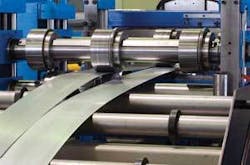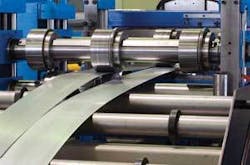Tailored strips direct from coil
Dortmund, Germany - Automobile seat rails, seat backrests, exhaust components, and wheel rims could, in the future, be manufactured from steel strips that are adapted from the outset to the stresses of the finished part. ThyssenKrupp Tailored Blanks GmbH (www.tailoredblanks.de) produces coils up to 15 metric tons, of steels of different thickness, grade, or coating on an uninterrupted laser welding line that is several hundred meters long.
Steel profiles are formed by running slit steel strip through a profiling line with several roller sets arranged in sequence. The roller sets bend the steel strip step-by-step to the cross section required for its later use. These strips can be made from different steels of different thickness or strength, allowing the production of profiles that are ideally adapted to the actual stresses of the finished part. This eliminates the need for subsequent reinforcement of highly stressed areas and enables customers to dispense with complete production steps.
Laser welded strips also meet corrosion protection requirements more cost effectively; the strips can be made up of coated and non-coated steel or a combination of carbon and stainless steel. These stress-oriented strips also permit similar weight reductions to tailored blanks of more than 20 percent.
Profiles are formed in a continuous process that requires the use of a strip from a coil. Tailor welded blanks are not suitable for this purpose. Until recently, joining long steel strips with an uninterrupted laser weld was regarded as technically impossible. Three-meter welds were the limit, and then only if the individual blanks were at least 200mm wide.
The problem is the strip edges, melted during laser welding, heat up and distort, increasing the gap between them to more than 0.08 mm. A weld cooling system, developed by ThyssenKrupp Tailored Blanks, copes with this problem. Also, a laser head swivels +/- 5 mm side to side to follow irregularities in the joining gap.
To keep irregularities to a minimum, the strips pass through levelers before they are guided to the welding station. The edges of the strips can also be prepared for welding by scraping, milling, or rounding. The tailored strip line in Dortmund can process slit steel strips in widths of 50-700 mm and thicknesses of 0.8-2.5 mm.

